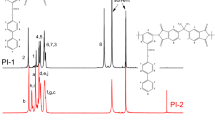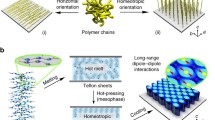Abstract
Four poly(oxadiazole-imide)s containing naphthalene rings, with different flexibility and molecular weight, are investigated with respect to their rheological properties to establish the optimal processing conditions from solution phase to film state for liquid crystal orientation purposes. The film uniformity and strength are determined by monitoring the flow behavior and chain entanglements. The solution rheological data are in agreement with film tensile testing, revealing that higher molecular weight favors chain entanglements and implicitly the film mechanical resistance. In order to analyze the suitability of these films as alignment layers their surface is patterned by rubbing with two types of velvet. Liquid crystal alignment of 4′-pentyl-4-biphenylcarbonitrile nematic is tested by polarized light microscopy. The resulting behavior is correlated with the polyimide malleability and characteristics of the textile fibers, namely their polarity, size, and mechanical features. The competitive effects between chain flexibility and entanglements, together with the interactions occurring between the polymer and velvet are analyzed in order to explain the surface regularity, which influences the uniformity of the liquid crystal alignment. The contrast between dark and bright states recorded on the liquid crystal cell indicates that some of these polynaphthalimides are promising candidates for liquid crystal display devices.

















Similar content being viewed by others
References
Barzic AI, Stoica I, Hulubei C (2012) Semi-alicyclic polyimides: insights into optical properties and morphology patterning approaches for advanced technologies. In: Abadie MJM (ed) High performance polymers–polyimides based—from chemistry to applications. InTech, Novi Sad, pp 167–214
Tongsheng L, Peihong C, Xujun L, Jiang T, Qunji X (2000) Tribophysical and tribochemical effects of a thermoplastic polyimide. J Mater Sci 35:2597–2601. doi:10.1023/A:1004775331707
Ghosh MK, Mittal KL (1996) Polyimides: fundamentals and applications. Marker Dekker, New York
Chen JP, Labarthet FL, Natansohn A, Rochon P (1999) Highly stable optically induced birefringence and holographic surface gratings on a new azocarbazole-based polyimide. Macromolecules 32:8572–8579
Garcia JM, Garcia F, Sanz R, de la Campa JG, Lozano AE, de Abajo J (2001) Synthesis and characterization of new soluble polyamides derived from 2,6-bis(4-aminophenyl)-3,5-dimethyltetrahydro-4H-pyran-4-one. J Polym Sci A 39:1825–1832
Staubli A, Mathiowitz E, Langer R (1991) Sequence distribution and its effect on glass transition temperatures of poly(anhydride-co-imides) containing asymmetric monomers. Macromolecules 24:2291–2298
Damaceanu MD, Rusu RD, Bruma M (2012) Six-member polyimides incorporating redox chromophores. J Mater Sci 47:6179–6188. doi:10.1007/s10853-012-6542-8
Pasahan A, Koytepe S, Ekinci E (2011) Synthesis, characterization of naphthalene-based polyimides, and their use as immobilized enzyme membrane. Polym Adv Technol 22:1940–1947
Damaceanu MD, Rusu RD, Nicolescu A, Bruma M (2011) Blue fluorescent polyamides containing naphthalene and oxadiazole rings. J Polym Sci A 49:893–906
Damaceanu MD, Rusu RD, Bruma M, Rusanov A (2010) Fluorinated heterocyclic polyperyleneimides. Rev Roum Chim 55:953–961
Kizhnyaev VN, Pokatilov FA, Vereshchagin LI (2008) Carbochain polymers with oxadiazole, triazole, and tetrazole cycles. Polym Sci Ser C 50:1–21
Kim SW, Shim SC, Jung BJ, Shim HK (2002) Synthesis and properties of new electroluminescent polymers possessing both hole and electron-transporting units in the main chain. Polymer 43:4297–4305
Liu JG, He MH, Zhou HW, Qian ZG, Wang FS, Yan SYJ (2002) Organosoluble and transparent polyimides derived from alicyclic dianhydride and aromatic diamines. Polym Sci A 40:110–119
Hahm SG, Lee TJ, Chang T, Jung JC, Zin WC, Ree M (2006) Unusual alignment of liquid crystals on rubbed films of polyimides with fluorenyl side groups. Macromolecules 39:5385–5392
Takatoh K, Hasegawa M, Koden M, Itoh N, Hasegawa R, Sakamoto M (2005) Alignment technologies and applications of liquid crystal devices. Taylor & Francis, London
Hirosawa I, Koganezawa T, Ishii H, Sakai T (2009) Effects of annealing on rubbed polyimide surface studied by grazing-incidence X-ray diffraction. IEICE Trans Electron E92C:1376–1381
Hirosawa I, Sasaki N, Kimura H (1999) Characterization of molecular orientation of rubbed polyimide film by grazing incidence X-ray scattering. Jpn J Appl Phys 38:L583–L585
Uchida T, Seki H (1992) Liquid crystals: applications and uses. World Scientific, Singapore
Barzic AI, Stoica I, Popovici D, Vlad S, Cozan V, Hulubei C (2013) An insight on the effect of rubbing textile fiber on morphology of some semi-alicyclic polyimides for liquid crystal orientation. Polym Bull 70:1553–1574
Geary JM, Goodby JW, Kemtz AR, Patel JS (1987) The mechanism of polymer alignment of liquid crystal materials. J Appl Phys 62:4100–4108
Damaceanu MD, Rusu RD, Bruma M, Jarzabek B (2010) Photo-optical properties of poly(oxadiazole-imide)s containing naphthalene rings. Polym J 42:663–669
Damaceanu MD, Rusu RD, Bruma M, Rusanov AL (2011) New thermally stable and organosoluble heterocyclic poly(naphthaleneimide)s. Polym Adv Technol 22:420–429
Rusu RD, Damaceanu MD, Bruma M, Ronova IA (2011) Effect of conformational parameters on thermal properties of some poly(oxadiazole-naphthylimide)s. Iran Polym J 20:29–40
Han Y, Fang XZ, Zuo XX (2010) The influence of molecular weight on properties of melt-processable copolyimides derived from thioetherdiphthalic anhydride isomers. J Mater Sci 45:1921–1929. doi:10.1007/s10853-009-4179-z
Teraoka I (2002) Polymer solutions: an introduction to physical properties. Wiley, New York
Krause WE, Bellomo EG, Colby RH (2001) Rheology of sodium hyaluronate under physiological conditions. Biomacromolecules 2:65–69
Bordi F, Colby RH, Cametti C, De Lorenzo L, Gili TJ (2002) Electrical conductivity of polyelectrolyte solutions in the semidilute and concentrated regime: the role of counterion condensation. J Phys Chem B 106:6887–6893
de Gennes PG (1979) Scaling concepts in polymer physics. Cornell University Pres, New York
Jenekhe SA (1983) The rheology and spin coating of polyimide solutions. Polym Eng Sci 23:830–834
Britten JA, Thomas IM (1992) Non-Newtonian flow effects during spin coating large-area optical coatings with colloidal suspensions. J Appl Phys 71:972–979
Gutzow I, Dobreva A, Schmelzer J (1993) Rheology of non-Newtonian glass-forming melts. J Mater Sci 28:901–908. doi:10.1007/BF00400872
Rennie TJ, Vijaya Raghavan GS (2007) Thermally dependent viscosity and non-Newtonian flow in a double-pipe helical heat exchanger. Appl Therm Eng 27:862–868
McNally T, McShane P, Nally GM, Murphy WR, Cook M, Miller A (2002) Rheology, phase morphology, mechanical, impact and thermal properties of polypropylene/metallocene catalysed ethylene 1-octene copolymer blends. Polymer 43:3785–3793
Cosutchi AI, Hulubei C, Ioan S (2007) Rheological study of some epiclon-based polyimides. J Macromol Sci B 46:1003–1012
Chisca S, Barzic AI, Sava I, Olaru N, Bruma M (2012) Morphological and rheological insights on polyimide chain entanglements for electrospinning produced fibers. J Phys Chem B 116:9082–9088
Cole KS, Cole RH (1941) Dispersion and absorption in dielectrics I. Alternating current characteristics. J Chem Phys 9:341–351
Harrell ER, Nakayama N (1984) Modified cole–cole plot based on viscoelastic properties for characterizing molecular architecture of elastomers. J Appl Polym Sci 29:995–1010
Cosutchi AI, Hulubei C, Stoica I, Dobromir M, Ioan S (2008) Structural and dielectric properties of some epiclon-based polyimide films. e-Polymers 8:778–792
Berreman DW (1973) Alignment of liquid crystals by grooved surfaces. Mol Cryst Liq Cryst 23:215–231
Murata M, Yoshida E, Uekita M, Tawada Y (1993) Effect molecular arrangement of alignment film for liquid crystals. Jpn J Appl Phys 32:L676–L678
Lee SW, Lee SJ, Hahm SG, Lee TJ, Lee B, Chae B, Seung BK, Jin CJ, Wang CZ, Byeong HS, Moonhor R (2005) Role of the n-alkyl end of bristles in governing liquid crystal alignment at rubbed films of brush polymer rods. Macromolecules 38:4331–4338
Johannsmann D, Zhou H (1993) Correlation between surface and bulk orientations of liquid crystals on rubbed polymer surfaces: odd–even effects of polymer spacer units. Phys Rev E 48:1889–1896
Kikuchi H, Logan JA, Yoon DY (1996) Study of local stress, morphology, and liquid–crystal alignment on buffed polyimide surfaces. J Appl Phys 79:6811–6817
Chae B, Kim SB, Lee SW, Kim SI, Choi W, Lee B, Ree M, Lee KH, Jung JC (2002) Surface morphology, molecular reorientation, and liquid crystal alignment properties of rubbed nanofilms of a well-defined brush polyimide with a fully rodlike backbone. Macromolecules 35:10119–10130
Acknowledgements
This work was financially supported by PNII-RU project, code TE_221/2010, no. 31/10.08.2010.
Author information
Authors and Affiliations
Corresponding author
Rights and permissions
About this article
Cite this article
Barzic, A.I., Rusu, R.D., Stoica, I. et al. Chain flexibility versus molecular entanglement response to rubbing deformation in designing poly(oxadiazole-naphthylimide)s as liquid crystal orientation layers. J Mater Sci 49, 3080–3098 (2014). https://doi.org/10.1007/s10853-013-8010-5
Received:
Accepted:
Published:
Issue Date:
DOI: https://doi.org/10.1007/s10853-013-8010-5




